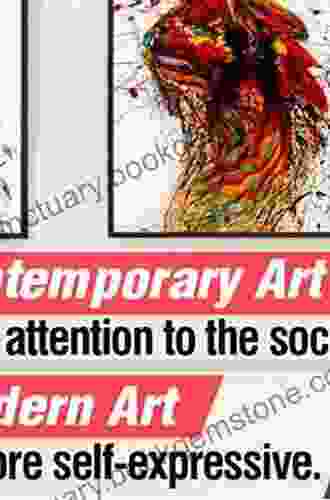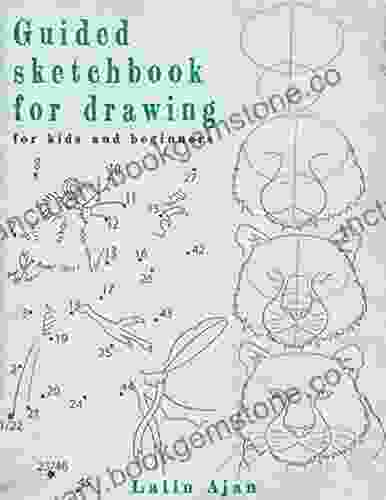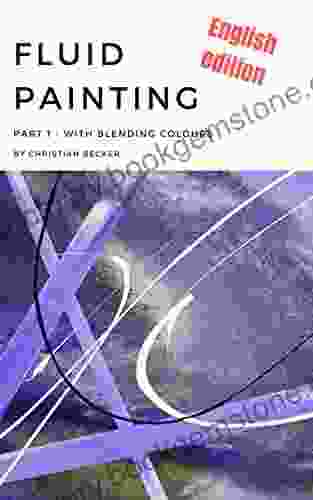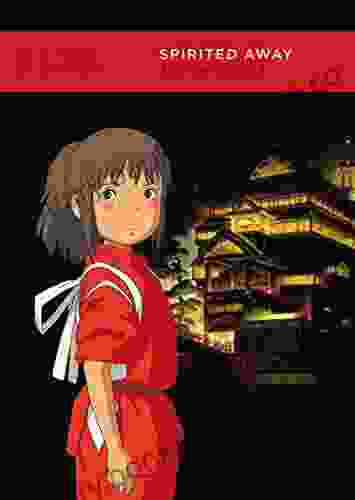Fluid Painting Part With Blending Colours English Edition: Exploring the Art of Liquid Canvas Manipulation

Fluid painting, also known as acrylic pouring, is a captivating art form that involves pouring acrylic paints onto a canvas or other surface, allowing them to flow and blend together to create unique and mesmerizing abstract patterns. This technique offers boundless creative possibilities, allowing artists to express themselves freely and experiment with colour combinations and textures.
Blending Colours: A Symphony of Hues
One of the most intriguing aspects of fluid painting is the ability to blend colours seamlessly, creating harmonious transitions and depth within the artwork. By carefully selecting and layering different colours, artists can achieve stunning visual effects that evoke a sense of movement, emotion, and tranquility.
5 out of 5
| Language | : | English |
| File size | : | 3942 KB |
| Text-to-Speech | : | Enabled |
| Screen Reader | : | Supported |
| Enhanced typesetting | : | Enabled |
| Print length | : | 8 pages |
| Lending | : | Enabled |
Colour Theory in Fluid Painting
Understanding basic colour theory is essential for effective blending in fluid painting. The colour wheel provides a systematic approach to colour relationships, helping artists identify complementary, analogous, and monochromatic colour schemes that harmonize well together. Experimenting with warm, cool, and neutral colours can create different moods and atmospheres within the artwork.
Techniques for Blending Colours
There are various techniques for blending colours while fluid painting. The following methods are commonly employed:
- Wet-on-wet technique: Pouring different colours directly onto a wet canvas surface allows them to blend and spread naturally, resulting in smooth transitions and soft gradients.
- Pouring cells: Creating cells is a unique technique that involves using silicone oil or other additives to split the colours into small, bubble-like formations. When these cells burst, they produce beautiful concentric circles and patterns.
- Swirling and tilting: Manipulating the canvas or panel after pouring the paint can encourage the colours to mix and swirl, creating dynamic and abstract patterns.
- Layering: Applying multiple layers of paint allows for greater control over colour blending. Each layer can be poured in a different colour or direction, resulting in a complex and stratified composition.
Materials and Preparation
Before embarking on a fluid painting adventure, it's important to gather the necessary materials and ensure proper canvas preparation:
Materials
- Acrylic paints in various colours
- Pouring medium (e.g., Floetrol, Liquitex Pouring Medium)
- Water
- Canvas or other painting surface
- Cups or pouring containers
- Sticks or brushes for stirring and manipulating the paint
- Blow dryer or heat gun (optional)
Canvas Preparation
Proper canvas preparation is crucial for successful fluid painting:
- Apply a layer of gesso (priming agent) to the canvas to create a smooth, receptive surface.
- Allow the gesso to dry completely.
- If desired, apply a layer of varnish or topcoat to protect the finished painting.
Step-by-Step Guide to Fluid Painting with Blending Colours
- Mix the paint: Combine acrylic paints with pouring medium and water in a cup or container. The ratio of paint to pouring medium depends on the desired consistency. A thinner consistency will result in more fluidity and blending, while a thicker consistency will produce more texture and definition.
- Pour the paints: Carefully pour the prepared paint onto the canvas. You can pour multiple colours simultaneously or pour them in layers. Experiment with different pouring techniques to create different effects.
- Manipulate the canvas: Tilt or rotate the canvas to encourage the paints to flow and blend. Use a stick or brush to gently swirl or push the paint around.
- Heat the painting (optional): Using a blow dryer or heat gun can help speed up the drying process and create additional effects, such as cracking or cell formation.
- Allow to dry: Allow the painting to dry completely before varnishing or framing.
Tips and Tricks for Successful Blending
- Use high-quality acrylic paints with good flow properties.
- Experiment with different pouring techniques to achieve various effects.
- Pay attention to colour theory and select complementary or analogous colours for harmonious blending.
- Use a canvas or surface that is large enough to allow for sufficient paint movement.
- Practice regularly to develop your skills and techniques.
Fluid painting with blending colours is an exciting and rewarding art form that offers endless possibilities for creativity and self-expression. By understanding colour theory, experimenting with techniques, and exploring different materials, artists can create stunning abstract paintings that capture the essence of fluidity and colour harmony. Whether you're a seasoned artist or just starting your artistic journey, fluid painting is an accessible and captivating medium that invites exploration and experimentation.
5 out of 5
| Language | : | English |
| File size | : | 3942 KB |
| Text-to-Speech | : | Enabled |
| Screen Reader | : | Supported |
| Enhanced typesetting | : | Enabled |
| Print length | : | 8 pages |
| Lending | : | Enabled |
Do you want to contribute by writing guest posts on this blog?
Please contact us and send us a resume of previous articles that you have written.
 Best Book
Best Book Page Flip
Page Flip Bookshelf
Bookshelf Literary loom
Literary loom Chapter
Chapter Bookish
Bookish PageTurner
PageTurner Bibliophile
Bibliophile Story
Story Inkwell
Inkwell Bookworm
Bookworm Labyrinth
Labyrinth Plot Twist
Plot Twist Prose
Prose Paperback
Paperback Storyteller
Storyteller Sanctuary
Sanctuary Fiction
Fiction Reading
Reading Chronicle
Chronicle Read
Read Haley Hoover
Haley Hoover J Bright
J Bright D C Palter
D C Palter Padma Lakshmi
Padma Lakshmi Guy Stern
Guy Stern Nancy Princenthal
Nancy Princenthal Diana Gabaldon
Diana Gabaldon Andrea Erickson
Andrea Erickson Mary Robinette Kowal
Mary Robinette Kowal Gabrielle Moss
Gabrielle Moss Robert Ludlum
Robert Ludlum Annabel Chase
Annabel Chase Paul Robert Walker
Paul Robert Walker Fred Botting
Fred Botting Nintendo
Nintendo Lynda Vaughn
Lynda Vaughn Jake Sherman
Jake Sherman Terry Newman
Terry Newman Van Lu
Van Lu Angus Donald
Angus Donald Angel Williams
Angel Williams Cissy Houston
Cissy Houston Jonathan Rauch
Jonathan Rauch Ann Blockley
Ann Blockley Scott Baron
Scott Baron Charles Reid
Charles Reid Danielle Geller
Danielle Geller Graeme Davis
Graeme Davis Stacey L Nash
Stacey L Nash Anna Starmer
Anna Starmer Andrew Sutton
Andrew Sutton Steven Bleicher
Steven Bleicher James T Deshields
James T Deshields Anika Fajardo
Anika Fajardo D C Robinson
D C Robinson Don Bluth
Don Bluth Sherry Ginn
Sherry Ginn Anna Nadler
Anna Nadler Scott Thybony
Scott Thybony Manuel Huitzilli
Manuel Huitzilli Liao Yiwu
Liao Yiwu Andrew Meier
Andrew Meier Josie Iselin
Josie Iselin Hamish Bowles
Hamish Bowles Emiko Davies
Emiko Davies Farha Ghannam
Farha Ghannam Bridget Alsdorf
Bridget Alsdorf Andrew Cunningham
Andrew Cunningham Ann C Hall
Ann C Hall Jack Porter
Jack Porter Glenn Adamson
Glenn Adamson Anna Salton Eisen
Anna Salton Eisen Fern Michaels
Fern Michaels Jamila Jasper
Jamila Jasper Anna Paola Sanna
Anna Paola Sanna Mark Horrell
Mark Horrell Nicole Grotepas
Nicole Grotepas George Kalmpourtzis
George Kalmpourtzis Jenny Schwartz
Jenny Schwartz Dita Von Teese
Dita Von Teese C L Parker
C L Parker Christie Taylor
Christie Taylor Andy Keen
Andy Keen Nina Willner
Nina Willner Sylvan Barnet
Sylvan Barnet Kimberly Brock
Kimberly Brock Angela Marie Moulton
Angela Marie Moulton Tim Slessor
Tim Slessor T J Demos
T J Demos Patrick Smithwick
Patrick Smithwick Kathryn Wilder
Kathryn Wilder Andrea Pflaumer
Andrea Pflaumer Kindle Edition With Audio Video
Kindle Edition With Audio Video Rickie Lee Jones
Rickie Lee Jones Josh Hanagarne
Josh Hanagarne Scott Bartlett
Scott Bartlett Magic Guidebooks
Magic Guidebooks Kristina Kozak
Kristina Kozak Marc Shapiro
Marc Shapiro Andrew Moor
Andrew Moor Tom Sileo
Tom Sileo Yan Lianke
Yan Lianke Anna Badkhen
Anna Badkhen Sam Fury
Sam Fury Patricia Preciado Martin
Patricia Preciado Martin Anna Malaika Tubbs
Anna Malaika Tubbs Michiyo
Michiyo Jeremy Mercer
Jeremy Mercer Ben G Frank
Ben G Frank Angelico Chavez
Angelico Chavez L T Ryan
L T Ryan Tiffany L Warren
Tiffany L Warren Holly Moss
Holly Moss Brian Shea
Brian Shea Leslie Redhead
Leslie Redhead Milton Glaser
Milton Glaser J B Rosenberg
J B Rosenberg Andrew Carroll
Andrew Carroll Melissa Riddell
Melissa Riddell Jane Dunnewold
Jane Dunnewold Andrei Codrescu
Andrei Codrescu Andrew Dewar
Andrew Dewar Harriet Welty Rochefort
Harriet Welty Rochefort Andrew Dickos
Andrew Dickos Charlie English
Charlie English Andrew Darby
Andrew Darby Maggie O Farrell
Maggie O Farrell Anita Nipane
Anita Nipane Quincy Jones
Quincy Jones Eric Seale
Eric Seale Waldemar Bogoras
Waldemar Bogoras Andy Herbach
Andy Herbach John C Cranham Dds
John C Cranham Dds Catherine Berry
Catherine Berry Caroline Linscott
Caroline Linscott Jill Braden
Jill Braden Ys Publishing
Ys Publishing Bruce Feiler
Bruce Feiler Dominic Roskrow
Dominic Roskrow Charla Krupp
Charla Krupp Anna Kirtlan
Anna Kirtlan Dorothy Hartley
Dorothy Hartley Andy Warhol
Andy Warhol Juanitta Baldwin
Juanitta Baldwin David Nees
David Nees Stephanie Laurens
Stephanie Laurens Anna Koliadych
Anna Koliadych Zane Lamprey
Zane Lamprey Anna Mocikat
Anna Mocikat Anna Hackett
Anna Hackett L J Martin
L J Martin Phoenix Collins
Phoenix Collins Stephen Kurkjian
Stephen Kurkjian Paul Reps
Paul Reps Dave Clayton
Dave Clayton Annalee Newitz
Annalee Newitz Michael Punke
Michael Punke Andrew M Dobell
Andrew M Dobell Annabelle Honess Roe
Annabelle Honess Roe Andrew Mayne
Andrew Mayne John M Olsen
John M Olsen Wendy Jelbert
Wendy Jelbert Dina Nayeri
Dina Nayeri Andrew Wilson
Andrew Wilson Andrew Vaillencourt
Andrew Vaillencourt Doris Kennedy
Doris Kennedy Billy Ray Belcourt
Billy Ray Belcourt Terry Brooks
Terry Brooks Crystal Daniels
Crystal Daniels Erika Warmbrunn
Erika Warmbrunn G J Younghusband
G J Younghusband Anna Bartlett
Anna Bartlett Elaine Welteroth
Elaine Welteroth Angelina Jolie
Angelina Jolie Shirley Anstis
Shirley Anstis Denys Johnson Davies
Denys Johnson Davies Louise Egerton
Louise Egerton Hilary Spurling
Hilary Spurling Frank Kennedy
Frank Kennedy Christine Leteux
Christine Leteux Andrew Hund
Andrew Hund Rob Craig
Rob Craig Roman Frister
Roman Frister Cion Lee
Cion Lee Ann Aguirre
Ann Aguirre Ann Budd
Ann Budd Michelle Lee
Michelle Lee Dominique Auzias
Dominique Auzias James Canton
James Canton Lance Esplund
Lance Esplund Kat Chow
Kat Chow Shawn Kelly
Shawn Kelly David J Dennis Jr
David J Dennis Jr Kate Frost
Kate Frost Royal Horticultural Society
Royal Horticultural Society Sarah Herman
Sarah Herman Regine Abel
Regine Abel Theodore Annemann
Theodore Annemann Anna M Mazur
Anna M Mazur Michael Asher
Michael Asher Jessica Alba
Jessica Alba Jeb Rosebrook
Jeb Rosebrook Andrew Karevik
Andrew Karevik Ruskin Bond
Ruskin Bond David Hampshire
David Hampshire Anna Corba
Anna Corba Henry Van Dyke
Henry Van Dyke Anna Pasternak
Anna Pasternak Anna Goldenberg
Anna Goldenberg Elisa Russell
Elisa Russell Anna Qu
Anna Qu Anna Jean Mayhew
Anna Jean Mayhew Andy Southall
Andy Southall Anne C Heller
Anne C Heller Angus Johnstone
Angus Johnstone Heather Galler
Heather Galler Kianna Alexander
Kianna Alexander Erin Lewis Fitzgerald
Erin Lewis Fitzgerald Anjan Chatterjee
Anjan Chatterjee Zachary Lamothe
Zachary Lamothe Jocelyn Harewood
Jocelyn Harewood Anna Stephens
Anna Stephens David Loud
David Loud Alex Tannen
Alex Tannen Angus Roxburgh
Angus Roxburgh Andrew Marble
Andrew Marble Tony Wheeler
Tony Wheeler Angus M Gunn
Angus M Gunn Pao Lor
Pao Lor Shannon Leone Fowler
Shannon Leone Fowler Robin Sloan
Robin Sloan David Blatner
David Blatner Marilyn Chase
Marilyn Chase Larry Silverberg
Larry Silverberg Betty Arnett
Betty Arnett Tetiana Elert
Tetiana Elert Jean Ann Shirey
Jean Ann Shirey Camil Flores
Camil Flores Joshua Rivkin
Joshua Rivkin Julie Ann Walker
Julie Ann Walker Nicholas Roerich
Nicholas Roerich Andrei Besedin
Andrei Besedin Angela Hunt
Angela Hunt Fawzia Koofi
Fawzia Koofi Octave Uzanne
Octave Uzanne Robin Koontz
Robin Koontz Andrew Vietze
Andrew Vietze J D Robb
J D Robb John Charles Bennett
John Charles Bennett Laurinda Reddig
Laurinda Reddig Andreas Marks
Andreas Marks Flavio Ferrari Zumbini
Flavio Ferrari Zumbini Mike Epps
Mike Epps Kitty Gorrell
Kitty Gorrell Kien Nguyen
Kien Nguyen Emily Bingham
Emily Bingham Ann Marks
Ann Marks Joseph E Persico
Joseph E Persico Emma Newman
Emma Newman Frederick Stirton Weaver
Frederick Stirton Weaver Anita Brookner
Anita Brookner Angie Cruz
Angie Cruz Marie Force
Marie Force R G Richardson
R G Richardson Angela Wolf
Angela Wolf Anita Heiss
Anita Heiss Natasha Solomons
Natasha Solomons Anne Bogart
Anne Bogart Ann Hoffman
Ann Hoffman Kliph Nesteroff
Kliph Nesteroff Kindle Edition
Kindle Edition Xander Black
Xander Black Yossi Maimon
Yossi Maimon Andy Mckell
Andy Mckell Andrew Parker
Andrew Parker Carlos Del Amor
Carlos Del Amor J N Chaney
J N Chaney Diane Esguerra
Diane Esguerra Liz Neves
Liz Neves Anjelah Johnson Reyes
Anjelah Johnson Reyes Andrew Delaplaine
Andrew Delaplaine Condoleezza Rice
Condoleezza Rice Bill Fawcett
Bill Fawcett Shellise Berry
Shellise Berry Gary Faigin
Gary Faigin Ann C Smith
Ann C Smith Laura Lee
Laura Lee Judy Omar
Judy Omar Erwin Panofsky
Erwin Panofsky Andrew Moriarty
Andrew Moriarty Siren
Siren Jason Sommer
Jason Sommer Angelo Colorni
Angelo Colorni Howard Thurston
Howard Thurston Kevin Grange
Kevin Grange Shel Perkins
Shel Perkins Daniella Weiss Ashkenazy
Daniella Weiss Ashkenazy Andrew Mcmahon
Andrew Mcmahon Ani Trime
Ani Trime Andrea Fazzari
Andrea Fazzari Andreas Deja
Andreas Deja Ann Cleeves
Ann Cleeves Andrea Lee
Andrea Lee Rhonda Mcknight
Rhonda Mcknight Christopher S Wood
Christopher S Wood J C Cooper
J C Cooper Andrew Tunstall
Andrew Tunstall Drew Kwong
Drew Kwong Lakisha Johnson
Lakisha Johnson Ed Duncan
Ed Duncan Margaret Wander Bonanno
Margaret Wander Bonanno Walter Foster
Walter Foster Sylvia Day
Sylvia Day Tina Brown
Tina Brown Ray Scippa
Ray Scippa James Martin
James Martin Chris Weyers
Chris Weyers Maxim Peter Griffin
Maxim Peter Griffin Andrew Bowden
Andrew Bowden Mia Sheridan
Mia Sheridan Anne Pannecke
Anne Pannecke Andy Davidson
Andy Davidson Anjali Enjeti
Anjali Enjeti Edward Bellamy
Edward Bellamy Disamis Arcia Munoz
Disamis Arcia Munoz Ann Beaglehole
Ann Beaglehole Isabel Allende
Isabel Allende Christopher Fowler
Christopher Fowler Lyonel Feininger
Lyonel Feininger E B Sledge
E B Sledge Angie Daniels
Angie Daniels Godfrey Baldacchino
Godfrey Baldacchino Ronnie Smith
Ronnie Smith Donald Preziosi
Donald Preziosi Michele Sullivan
Michele Sullivan Mari K Eder
Mari K Eder Sergio Bizzio
Sergio Bizzio Cornel West
Cornel West Darrin Duford
Darrin Duford Jack Gernsheimer
Jack Gernsheimer Jane Akshar
Jane Akshar Susan Ross
Susan Ross Jack Lucas
Jack Lucas Gary Spetz
Gary Spetz John Patrick Bray
John Patrick Bray Michael Howard
Michael Howard Anne Billson
Anne Billson John Driver
John Driver Carole Jackson
Carole Jackson Anna Todd
Anna Todd Fred Saberhagen
Fred Saberhagen Lisa Dickey
Lisa Dickey Ted Kerasote
Ted Kerasote Andrew Haslam
Andrew Haslam John Sugden
John Sugden Angelique V Nixon
Angelique V Nixon Laura Bradbury
Laura Bradbury Rita Moreno
Rita Moreno Duncan Heath
Duncan Heath Jarrett Brandon Early
Jarrett Brandon Early Andrew Porwancher
Andrew Porwancher Katrina Mcpherson
Katrina Mcpherson Jeff Fletcher
Jeff Fletcher Bernie Marcus
Bernie Marcus Marina Benjamin
Marina Benjamin W H Bartlett
W H Bartlett Clemantine Wamariya
Clemantine Wamariya Mark Henwick
Mark Henwick Julie Klassen
Julie Klassen Robert Alan Brookey
Robert Alan Brookey B Love
B Love Bathroom Readers Institute
Bathroom Readers Institute Michael Tubbs
Michael Tubbs Angie Martinez
Angie Martinez Ryan White
Ryan White Lonneke Geerlings
Lonneke Geerlings Denny S Bryce
Denny S Bryce Christina Klein
Christina Klein William W Johnstone
William W Johnstone Taylor Michaels
Taylor Michaels John F Mullins
John F Mullins Andrea Jackson
Andrea Jackson Martin Cruz Smith
Martin Cruz Smith Royd Tolkien
Royd Tolkien Frederic Lombardi
Frederic Lombardi Andrew Johnson
Andrew Johnson Angharad Lewis
Angharad Lewis Anette Fischer
Anette Fischer Andrew Juniper
Andrew Juniper Nicholas Meyer
Nicholas Meyer Andy Mcnab
Andy Mcnab E M Foner
E M Foner Andrew Forkner
Andrew Forkner Andrew Bostock
Andrew Bostock Jason Kramar
Jason Kramar Dawnie Walton
Dawnie Walton Kristina Liu
Kristina Liu Jane Hamilton
Jane Hamilton Andrew Osmond
Andrew Osmond Annie Dillard
Annie Dillard Ernesto Che Guevara
Ernesto Che Guevara Anna Cavallo
Anna Cavallo Monica Moody
Monica Moody Edward Seidensticker
Edward Seidensticker Christopher Greyson
Christopher Greyson Sarah Ferguson
Sarah Ferguson C Y Croc
C Y Croc Andy Mcdermott
Andy Mcdermott Charles Bukowski
Charles Bukowski Raymond F Jones
Raymond F Jones Val Wake
Val Wake Legacy Russell
Legacy Russell Jeffrey Chipps Smith
Jeffrey Chipps Smith Angela Gaughan
Angela Gaughan Andrew Grant
Andrew Grant Danielle Prescod
Danielle Prescod Elizabeth L Block
Elizabeth L Block David Mamet
David Mamet Harry Houdini
Harry Houdini Barbara Lasalle
Barbara Lasalle Anna Sherman
Anna Sherman Andrea Pomerantz Lustig
Andrea Pomerantz Lustig Simon Schama
Simon Schama Sara Funduk
Sara Funduk Kent Babb
Kent Babb Emily Louise Howard
Emily Louise Howard Andrew Graham Dixon
Andrew Graham Dixon Gavin Ambrose
Gavin Ambrose Octavio Solis
Octavio Solis Anna Deavere Smith
Anna Deavere Smith Luis Carlos Montalvan
Luis Carlos Montalvan Kent Wong
Kent Wong Rachel Rubin Wolf
Rachel Rubin Wolf John Gilstrap
John Gilstrap Angie Grace
Angie Grace Stuart Campbell
Stuart Campbell William J Lederer
William J Lederer Caroline James
Caroline James Angela D French
Angela D French Barbara Sillery
Barbara Sillery Ernest Hemingway
Ernest Hemingway
Light bulbAdvertise smarter! Our strategic ad space ensures maximum exposure. Reserve your spot today!

 Robert Louis StevensonMaster Thieves: The Boston Gangsters Who Pulled Off The World S Greatest Art...
Robert Louis StevensonMaster Thieves: The Boston Gangsters Who Pulled Off The World S Greatest Art...
 Gabriel HayesDeath in the Afternoon: A Journey into the World of Bullfighting by Ernest...
Gabriel HayesDeath in the Afternoon: A Journey into the World of Bullfighting by Ernest... Frank ButlerFollow ·2.1k
Frank ButlerFollow ·2.1k Mitch FosterFollow ·7.8k
Mitch FosterFollow ·7.8k Andrew BellFollow ·6.2k
Andrew BellFollow ·6.2k Neal WardFollow ·19.6k
Neal WardFollow ·19.6k Stephen FosterFollow ·19.5k
Stephen FosterFollow ·19.5k Roger TurnerFollow ·14.5k
Roger TurnerFollow ·14.5k August HayesFollow ·3.2k
August HayesFollow ·3.2k David BaldacciFollow ·13.4k
David BaldacciFollow ·13.4k

 Ethan Mitchell
Ethan MitchellWe Are Here To Hurt Each Other: A Deep Dive into the...
Yes, I can help you with that. Here is an...

 Xavier Bell
Xavier BellHannah Arendt: A Life in Dark Times
Hannah Arendt was a...

 Donovan Carter
Donovan CarterThe Art of Looking: A Comprehensive Exploration of Visual...
: The Power of...

 Terence Nelson
Terence NelsonUnveiling the Secrets of Moscow's Red Square: A Journey...
In the heart of Moscow,...

 Cruz Simmons
Cruz SimmonsDrawing Workbook for Kids and Beginners: An Enchanting...
: Unveiling the Magic of Drawing Drawing, an...
5 out of 5
| Language | : | English |
| File size | : | 3942 KB |
| Text-to-Speech | : | Enabled |
| Screen Reader | : | Supported |
| Enhanced typesetting | : | Enabled |
| Print length | : | 8 pages |
| Lending | : | Enabled |










